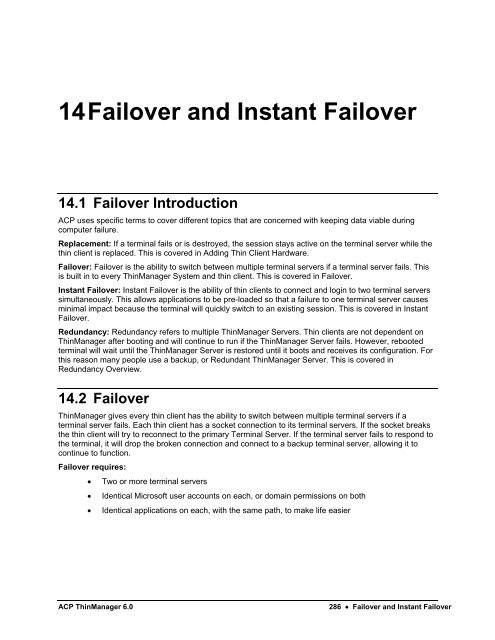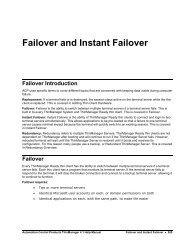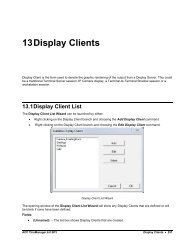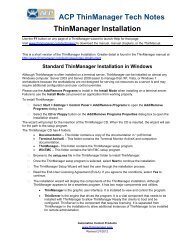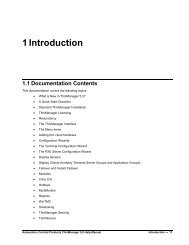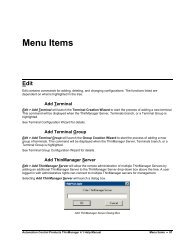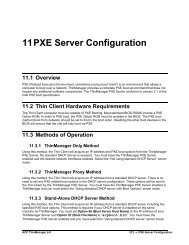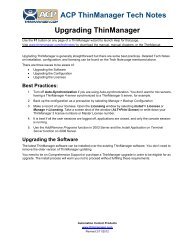Failover and Instant Failover - ThinManager
Failover and Instant Failover - ThinManager
Failover and Instant Failover - ThinManager
- No tags were found...
You also want an ePaper? Increase the reach of your titles
YUMPU automatically turns print PDFs into web optimized ePapers that Google loves.
14 <strong>Failover</strong> <strong>and</strong> <strong>Instant</strong> <strong>Failover</strong>14.1 <strong>Failover</strong> IntroductionACP uses specific terms to cover different topics that are concerned with keeping data viable duringcomputer failure.Replacement: If a terminal fails or is destroyed, the session stays active on the terminal server while thethin client is replaced. This is covered in Adding Thin Client Hardware.<strong>Failover</strong>: <strong>Failover</strong> is the ability to switch between multiple terminal servers if a terminal server fails. Thisis built in to every <strong>ThinManager</strong> System <strong>and</strong> thin client. This is covered in <strong>Failover</strong>.<strong>Instant</strong> <strong>Failover</strong>: <strong>Instant</strong> <strong>Failover</strong> is the ability of thin clients to connect <strong>and</strong> login to two terminal serverssimultaneously. This allows applications to be pre-loaded so that a failure to one terminal server causesminimal impact because the terminal will quickly switch to an existing session. This is covered in <strong>Instant</strong><strong>Failover</strong>.Redundancy: Redundancy refers to multiple <strong>ThinManager</strong> Servers. Thin clients are not dependent on<strong>ThinManager</strong> after booting <strong>and</strong> will continue to run if the <strong>ThinManager</strong> Server fails. However, rebootedterminal will wait until the <strong>ThinManager</strong> Server is restored until it boots <strong>and</strong> receives its configuration. Forthis reason many people use a backup, or Redundant <strong>ThinManager</strong> Server. This is covered inRedundancy Overview.14.2 <strong>Failover</strong><strong>ThinManager</strong> gives every thin client has the ability to switch between multiple terminal servers if aterminal server fails. Each thin client has a socket connection to its terminal servers. If the socket breaksthe thin client will try to reconnect to the primary Terminal Server. If the terminal server fails to respond tothe terminal, it will drop the broken connection <strong>and</strong> connect to a backup terminal server, allowing it tocontinue to function.<strong>Failover</strong> requires: Two or more terminal servers Identical Microsoft user accounts on each, or domain permissions on both Identical applications on each, with the same path, to make life easierACP <strong>ThinManager</strong> 6.0286 <strong>Failover</strong> <strong>and</strong> <strong>Instant</strong> <strong>Failover</strong>
<strong>Failover</strong> Step 1 – Session on Primary Terminal ServerThe thin client is configured to use two or more terminal servers.<strong>Failover</strong> Step 2 – Primary Terminal Server FailureIf the connection between the thin client <strong>and</strong> terminal server fails the thin client will retry the connection.ACP <strong>ThinManager</strong> 6.0 <strong>Failover</strong> <strong>and</strong> <strong>Instant</strong> <strong>Failover</strong> 287
<strong>Failover</strong> Step 3 – Thin Client Automatically Switches to Secondary Terminal ServerIf the thin client cannot connect to the primary terminal server it will automatically switch to the nextterminal server in the list, <strong>and</strong> start a new session.<strong>Failover</strong> Step 4 – Thin client has Session Running on Secondary Terminal ServerOnce connected it will login <strong>and</strong> launch the AppLink application. Any runtime data will remain constantsince both servers are drawing the same runtime data from the production floor.Note: This does not synchronize the hard drives. <strong>Failover</strong> gives you the ability to continue to run the thinclient by connecting to a backup. Data pulled from an outside source like a PLC or file server would bethe same on either terminal server.14.2.1 <strong>Failover</strong> Setup in Terminal Services Display Clients<strong>Failover</strong> is configured in the Display Client Configuration Wizard. Terminal Services Display Clients allowa terminal to run a session from a list of terminal servers. The Display Client will have <strong>Failover</strong> capability iftwo or more terminal servers added to it.Launch the Display Client Wizard by right clicking on the Display Clients branch in the tree. Alternatively,you can right click on an existing Terminal Services Display client in the tree <strong>and</strong> select Modify.288 <strong>Failover</strong> <strong>and</strong> <strong>Instant</strong> <strong>Failover</strong> ACP <strong>ThinManager</strong> 6.0
Display Client ListSelect the Add button to add a new Display Client, or highlight an existing Terminal Services DisplayClient <strong>and</strong> select the Edit button to edit an existing Display Client.Display Client Wizard – Display Client MembersMember terminal servers are added on the Display Clients Members page. Adding two or more terminalservers to the Selected Terminal Servers field will enable failover. The terminal will connect to theterminal servers in the order given, unless the Display Client is using SmartSession.ACP <strong>ThinManager</strong> 6.0 <strong>Failover</strong> <strong>and</strong> <strong>Instant</strong> <strong>Failover</strong> 289
Terminal Services Display Client OptionsSmartSession uses the CPU usage, Memory usage, <strong>and</strong> the number of sessions on a terminal server todetermine its load. Terminals using Terminal Services Display Clients with SmartSession will start asession on the server with the lightest load, instead of the order listed.Selecting the SmartSession checkbox on the Display Client Options page of the Display ClientWizard configures SmartSession. When SmartSession is used the Enforce Primary checkbox is nolonger relevant.290 <strong>Failover</strong> <strong>and</strong> <strong>Instant</strong> <strong>Failover</strong> ACP <strong>ThinManager</strong> 6.0
14.3 <strong>Instant</strong> <strong>Failover</strong>Every <strong>ThinManager</strong> thin client can be configured to use basic failover. Detecting that the primary server isdown <strong>and</strong> connecting to a backup server is usually achieved in10 to 20 seconds, depending on themonitoring configuration. Some applications will need additional time to launch <strong>and</strong> initialize theprograms. <strong>Instant</strong> <strong>Failover</strong> was developed for people who need the session to switch to another terminalserver <strong>and</strong> start running immediately, without any delays for starting the applications.When using <strong>Instant</strong> <strong>Failover</strong>, the thin client starts sessions on two servers at once. The sessions arecascaded on the thin client, with the primary session on top. If the primary terminal server fails, thepreexisting secondary session is switched to the forefront.Note: Use a Username, Password, <strong>and</strong> Initial Program to allow the thin client to login automatically <strong>and</strong>start a program so that the background session is immediately ready <strong>and</strong> not needing a login <strong>and</strong>program launch.<strong>Instant</strong> <strong>Failover</strong> Step 1 – Session on Two Terminal Servers<strong>Instant</strong> <strong>Failover</strong> configures the thin client to make connections to two terminal servers for each AppLinkDisplay Client. These will be cascaded so only the primary session is shown. There is an optional hot keytoggle available to allow toggling between sessions. See Hotkey Configuration for details.This allows the thin client to connect <strong>and</strong> initialize a session on a backup server so you don’t have to waitfor the session to load.ACP <strong>ThinManager</strong> 6.0 <strong>Failover</strong> <strong>and</strong> <strong>Instant</strong> <strong>Failover</strong> 291
<strong>Instant</strong> <strong>Failover</strong> Step 2 – Primary Terminal Server FailureThe thin client has a socket connection to each terminal server so it will quickly detect a terminal serverfailure.<strong>Instant</strong> <strong>Failover</strong> Step 3 – Switching to Backup Session on Secondary Terminal ServerAs soon as the thin client detects the failure of the primary terminal server the thin client will switch to thebackup session <strong>and</strong> pull it to the foreground. Since the session is already initialized you don’t have to waitfor your control system to load.292 <strong>Failover</strong> <strong>and</strong> <strong>Instant</strong> <strong>Failover</strong> ACP <strong>ThinManager</strong> 6.0
<strong>Instant</strong> <strong>Failover</strong> Step 4 – Session on Secondary Terminal Server<strong>Instant</strong> <strong>Failover</strong> allows the thin client to use two active sessions to prevent downtime.Note: <strong>Instant</strong> <strong>Failover</strong> is free from <strong>ThinManager</strong> but usually requires two application licenses since youhave two active sessions. Please see your application vendors for details on their licensing policies.If three or more terminal servers are in the Selected Terminal Server list, the thin client will connect to anew backup to ensure that it has an active backup.If the Enforce Primary feature is used, the thin client will switch back to the primary once it is backonline.14.4 <strong>Instant</strong> <strong>Failover</strong> Configuration<strong>Instant</strong> <strong>Failover</strong> is configured as part of Terminal Services Display Clients Wizard.14.4.1 <strong>Instant</strong> <strong>Failover</strong> Setup in Terminal Services Display ClientsTerminal Services Display Clients allow a terminal to run a session from a list of terminal servers. TheDisplay Client will have <strong>Instant</strong> <strong>Failover</strong> capability if two or more terminal servers added to it <strong>and</strong> the<strong>Instant</strong> <strong>Failover</strong> option is selected. This is configured in the Terminal Services Display Client Wizard.Launch the Display Client Wizard by right clicking on the Display Clients branch in the tree. Alternatively,you can right click on an existing Terminal Services Display client in the tree <strong>and</strong> select Modify.ACP <strong>ThinManager</strong> 6.0 <strong>Failover</strong> <strong>and</strong> <strong>Instant</strong> <strong>Failover</strong> 293
Display Client ListSelect the Add button to add a new Display Client, or highlight an existing Terminal Services DisplayClient <strong>and</strong> select the Edit button to edit an existing Display Client.294 <strong>Failover</strong> <strong>and</strong> <strong>Instant</strong> <strong>Failover</strong> ACP <strong>ThinManager</strong> 6.0
Display Client Wizard – Terminal Services <strong>and</strong> Workstations Options PageSelect the <strong>Instant</strong> <strong>Failover</strong> check box on the Display Client Options page to enable instant failover forthe Display Client.Note: Do not use the <strong>Instant</strong> <strong>Failover</strong> Module when using <strong>Instant</strong> <strong>Failover</strong> within a Display ClientThe Terminal Services Options page allows the configuration of other parameters in addition to the<strong>Instant</strong> <strong>Failover</strong> such as SmartSession <strong>and</strong> AppLink. See Terminal Services Display Client Options fordetails.Each Terminal Services Display Client needs two or more terminal servers to get <strong>Instant</strong> <strong>Failover</strong> tofunction. This is done on the Display Clients Members page of the Display Client Wizard.Display Client Wizard – Display Client Members PageSelect two or more terminal servers from the Available Terminal Servers list <strong>and</strong> move them to theSelected Terminal Servers list by highlighting <strong>and</strong> double clicking, or by using the Arrow button.The thin client will start sessions on the top two terminal servers in the Select Terminal Server list, withthe top terminal server as the primary <strong>and</strong> the second terminal server as the backup, unlessSmartSession was chosen on the Group Options page.If more than two terminal servers are selected, the thin client will connect to the other terminal servers ifone of the other terminal servers fails.ACP <strong>ThinManager</strong> 6.0 <strong>Failover</strong> <strong>and</strong> <strong>Instant</strong> <strong>Failover</strong> 295
14.4.2 Switching Between Sessions with Display Clients<strong>Instant</strong> <strong>Failover</strong> can be configured to allow a user to toggle between the two instant failover sessionswhen the thin client is using Display Clients by using a hotkey. To configure the hotkey run the TerminalConfiguration Wizard for the terminal or terminal group that is using a Terminal Services Display Clientwith <strong>Instant</strong> <strong>Failover</strong> <strong>and</strong> proceed to the Hotkey Configuration page.Terminal Configuration Wizard – Hotkey Configuration PageWhen a thin client is using Terminal Services Display Clients, selecting the Enable <strong>Instant</strong> <strong>Failover</strong>Hotkeys check box will allow the user to switch between instant failover sessions using the default CTL +F9 hot key.The default hotkey can be changed by selecting the upper Change Hotkeys button <strong>and</strong> launching theSelect Hotkeys windows.Note: The hotkey will not work properly if Enforce Primary is selected as a Display Client option on theTerminal Services Options page. As soon as you try to switch to the backup the thin client will switch youback to the Primary Terminal Server. It is recommended that you uncheck the Enforce Primary option ifyou plan on using the <strong>Instant</strong> <strong>Failover</strong> hotkey.296 <strong>Failover</strong> <strong>and</strong> <strong>Instant</strong> <strong>Failover</strong> ACP <strong>ThinManager</strong> 6.0
Select Hotkeys WindowsThe hot keys needed to switch between instant failover sessions can be changed on the Select Hotkeyswindow. Select the Control Key or Alt Key radio button <strong>and</strong> a function key from the drop down box <strong>and</strong>select the OK button to accept the changes.14.4.3 <strong>Instant</strong> <strong>Failover</strong> Tree IconsUnder each Terminal are icons representing the Terminal Servers that they connect to. The lightning boltcolor indicated the connection status.Terminal Server Connection IconsA Red lightning bolt represents a lack of connection to the terminal server.A Green lightning bolt represents a connection to the terminal server with an active session.A Yellow lightning bolt represents a connection to the terminal server with an active session that is thebackup in <strong>Instant</strong> <strong>Failover</strong> mode.ACP <strong>ThinManager</strong> 6.0 <strong>Failover</strong> <strong>and</strong> <strong>Instant</strong> <strong>Failover</strong> 297
<strong>Instant</strong> <strong>Failover</strong>If a terminal that is configured for <strong>Instant</strong> <strong>Failover</strong> is exp<strong>and</strong>ed in the <strong>ThinManager</strong> tree, the PrimaryTerminal Server should have a green lightning bolt, while the Secondary Terminal Server should have ayellow lightning bolt.In this example the primary session is on Green22 <strong>and</strong> it shows a green lightning bolt icon. Blue21 is thesecondary session <strong>and</strong> has a yellow lightning bolt icon. Peach23 is the third server in the list <strong>and</strong> has ared lightning bolt icon. This means that it doesn’t have an active session but is available if server 1 orserver 2 go offline.298 <strong>Failover</strong> <strong>and</strong> <strong>Instant</strong> <strong>Failover</strong> ACP <strong>ThinManager</strong> 6.0


